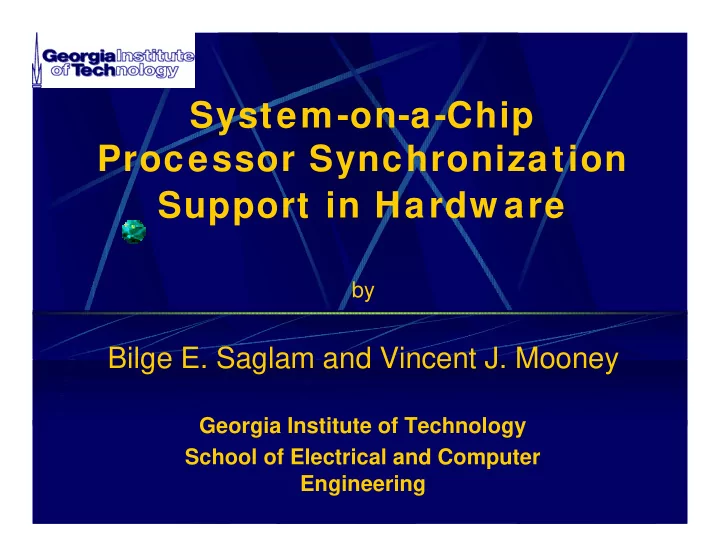

System-on-a-Chip Processor Synchronization Support in Hardw are by Bilge E. Saglam and Vincent J. Mooney Georgia Institute of Technology School of Electrical and Computer Engineering
Outline Background Motivation Methodology SoCSU Lock Cache Hardware Mechanism � Software Support for SoCSU � Experimental Set-up Hardware and Software Architectures � Database Example Simulation � Results Conclusion
Background Critical Section Code section where shared data between � multiple execution units is accessed E.g., multiple readers and multiple writers � A lock is necessary to guarantee the � consistency of shared data (e.g., global variables) Lock Delay Time between release and acquisition of a lock � Lock Latency Time to acquire a lock in the absence of � contention
Background (Continued) Atomic Locking � Special load/store instructions � ‘LL’ – load linked and ‘SC’ – store conditional (MIPS) � ‘lwarx’ and ‘stwcx.’ (MPC750) � Paired instructions � Breakable link for Effective Address (EA) � Synchronization Primitives � Test-and-Set, Compare-and-Swap, Fetch-and- Increment primitives Ensuring mutual exclusiveness and consistency
Background (Continued) test-and-set primitive TRY : LL r2, (r1) ; load lock variable ORI r3, r2, 1 ; set r3 = 1 BEQ r3, r2, TRY ; unlocked? SC r3, (r1) ; try locking BEQ r3, 0, TRY ; succeed? …./* critical section here */…. ANDI r2, r2, 0 ; set r2 = 0 SW r2, (r1) ; unlock lock variable Problem: busy-wait !
Motivation Previous Software Solutions � spin-on-test-and-set,spin-on-read, static/adaptive delay in loops,queue algorithms (Anderson’90, etc.) � poor in terms of bandwidth consumption, lock delay, lock latency � cache invalidations � hold cycles Previous Hardware Solutions � special cache schemes, each processor has a private cache directory for locks (Ramachandran’96, etc.) � dependent on memory hierarchy (special consistency model)
Motivation (Continued) Solution in hardware: SoCSU Lock Cache Deterministic and much faster access to lock variables Better performance in terms of lock delay, lock latency and bandwidth consumption Higher scalability for multi- processor SoC designs RTOS support
Methodology SoCSU Lock Cache Hardw are Mechanism P2 P1 PN Memory SoCSU Decoder and Lock Arbit rat ion Logic Cache
Methodology (Continued) SoCSU Lock Cache Hardw are
Methodology (Continued) SoCSU Lock Cache Hardw are Mechanism Interrupt Generation � Programmable priority assignment during system reset � Notify one processor at a time � preventing unnecessary signaling � Priority or FIFO
Methodology Softw are Example for SoCSU Traditional code for spin-lock C: Lock ( lock variable ); …/*critical section*/… UnLock ( lock variable ); ASM: try : LL R2,(R1) ;read the lock ORI R3,R2,1 BEQ R3,R2, try ;spin if lock is busy SC R3,(R1) ;acquire the lock BEQ R3,0, try ;spin if store fails …/*critical section*/… SW R2, (R1) ;release lock
Methodology (Continued) Softw are Example for SoCSU New code with SoCSU Lock Cache HW support C: Lock ( lock variable ); …/*critical section*/… UnLock ( lock variable ); ASM: try : LW R2,(R1) ;read the lock BEQ R2,1,sleep ;succeed? …/*critical section*/… SW R2, (R1) ;release lock
SoCSU Lock Cache vs. Traditional Implementation SoCSU Tradit ional P1 P2 P2 Task1 Task2 Task2 Lock(); Lock(); Lock(); Succeed Fail Fail C.S. Sleep(); Unlock(); � I nt errupt Cont end Lock(); Lock(); Succeed Succeed? C.S. C.S. Unlock(); Unlock();
Methodology (Continued) SoCSU Softw are Implementation Special load (LL) and store (SC) instructions removed Latency reduced Assumption: only small critical sections sleep instead of context switch ISR enables the sleeping task to return back to its original program flow ISR: mflr %r0 mtspr %SRR0, %r0 rfi No need to save context; high responsiveness
Experimental Set-up Seamless Co-Verification Environment (Seamless CVE) Seamless processor support packages for PPC family (we are using MPC750) Instruction set simulators Synopsys VCS verilog simulator RTOS – using uC/OS-II
Experimental Set-up (Continued) Database Example Simulation Four MPC750 processors Database example application combined with client/server pair execution model Thread-level synchronization - each thread acquires a lock - a transaction = accessing a database (critical section) - SoCSU provides synchronization
Database Example Simulation (Continued) Server accesses to shared memory object after acquiring lock from SoCSU Lock Cache Shared Client Server Memory Server reads from its own local memory into the shared memory object Server notifies client by Client Server releasing the lock (interrupt Local Local sent from SoCSU Lock Memory Memory Cache) Client acquires the lock and copies the data from shared memory into its own local memory
Results Simulation with 10 server tasks on one processor and 30 client tasks on the other 3 processors Worst case experimental results for 4-processor simulation (comparing SoCSU approach with the traditional spin-lock method): Spin-Lock SoCSU Lock Cache Lock Latency 17 3.5 (#clk cycles) Lock Delay 15578 34.5 (#clk cycles) Total Execution 1326311 1040714 time (#clk cycles) Total execution time � 27% speedup Lock delay � 451 times, Lock latency � 4.8 times
Conclusion & Future Work A hardware mechanism for multi-processor SoC Synchronization: SoCSU Lock Cache Reduction in lock latency, lock delay Constant traffic contention complexity 27% overall speedup in an example database application Note: patent pending Future Work � Support both long Critical Sections and short Critical Sections � Allow context-switching of tasks instead of sleeping � RTOS modifications � Hardware Modifications
Recommend
More recommend